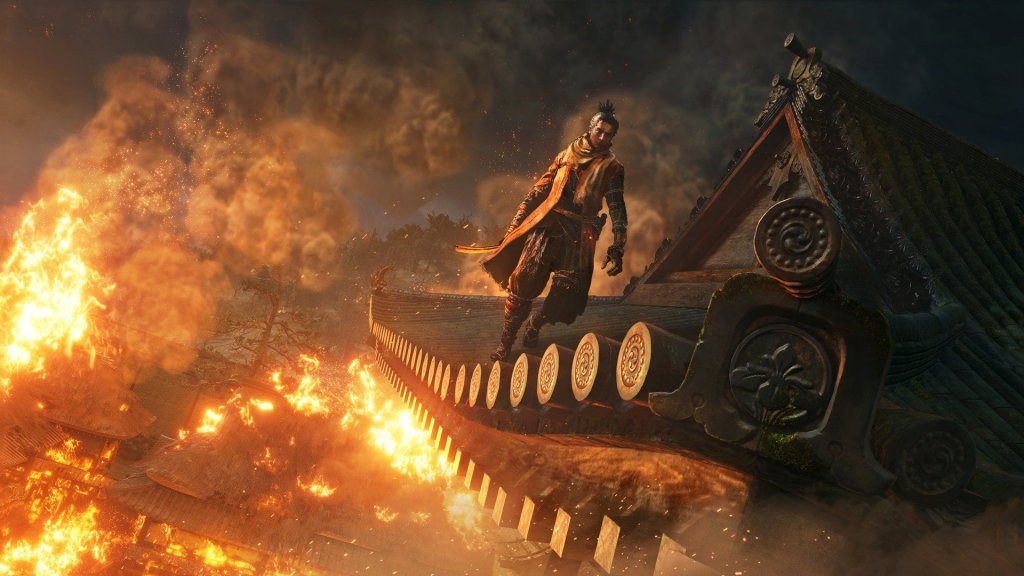More details about FromSoftware’s upcoming action game, Sekiro: Shadows Die Twice, have emerged from an interview at Famitsu with the game’s director, Hidetaka Miyazaki. In the interview, Miyazaki provided information on the game’s story and combat, Activision’s involvement with the project, the game’s setting, and more.
According to Miyazaki, Sekiro begins with the ideas of rescue and revenge. “But the prince [Sekiro] was bound to serve was kidnapped, his arm cut off, and he killed. After he thus lost everything, a one-armed sculptor of Buddhist imagery found him, “revived” him, and gave him a prosthetic shinobi arm. This is where the story starts.” Sekiro will seem to have a more focused, cohesive narrative than that of previous FromSoftware titles like Bloodborne and Dark Souls.
He then gave a list outlining the design philosophies behind Sekiro and how it differs from FromSoftware’s previous works (including the already fast-paced Bloodborne) in terms of action and combat.
“First, action uses the grappling hook. Being able to vertically traverse a three-dimensional map, which is unique to this game, will allows players to better enjoy the map.” He continues, “Second, the swordplay. This work has a unique perspective on swordplay, based on the Japanese style of swords furiously clashing together in mixed offense and defense, as [fighters] seek to wear down and debase their opponent’s posture. [..] And third is the idea of ‘kill wisely.’ You can attack head-on, or use the surroundings and your weapons to ‘kill clever’ in a fashion more apt to ninjas than to samurai.”
Sekiro sounds like a mix of 2006’s Tenchu Z, 2009’s Ninja Blade, 2015’s Bloodborne, and 2016’s Dark Souls III. It also sounds like FromSoftware has taken some cues from Team Ninja, developers behind Ninja Gaiden and Dark Souls clone Nioh.
Aware of the raised eyebrows when Activision’s name came up as attached to the project, Miyazaki assured us that “all decisions about game development are made by [FromSoftware]. While Activision’s name garners appropriate groans from gaming fans, Miyazaki made it clear that “[FromSoftware has asked] that all decisions after the title screen be left to us, and we’ve been successful in collaborating under this framework.” Though it’s difficult to ascertain what kind of relationship Activision really has with Sekiro, it’s safe to assume that FromSoftware wouldn’t jeopardize the game’s integrity nor the studio’s name for the sake of a publisher.
Lastly, Miyazaki talked about the game’s setting, going into detail about why it’s set Sengoku Japan instead of Edo Japan.
It’s based on the end of the Warring States period. As with our previous works, the actual setting isn’t firmly placed anywhere, but it has an image of a cold and elevated rural area. To explain why we chose the end of the Warring States period: first off, we had to make a choice between Warring States and Edo, given that the game is about ninjas. The reason we chose the Warring States period is because, first, combat in the period is thought of as more raw and dirty, which conforms more closely with my conception of ninjas. Second, with regards to conceit, Warring States is closer to the Middle Ages, which has more of a mythological feel, and Edo is closer to the modern age, with more of a living, breathing feel. Then, we chose the end of the period in order to incorporate the idea of decay. My conception of “Japanese beauty” requires it!
Sekiro: Shadows Die Twice is slated for a 2019 release for PC, PlayStation 4, and Xbox One. If you haven’t seen the reveal trailer, you can watch it above.
[Source via Reddit]






